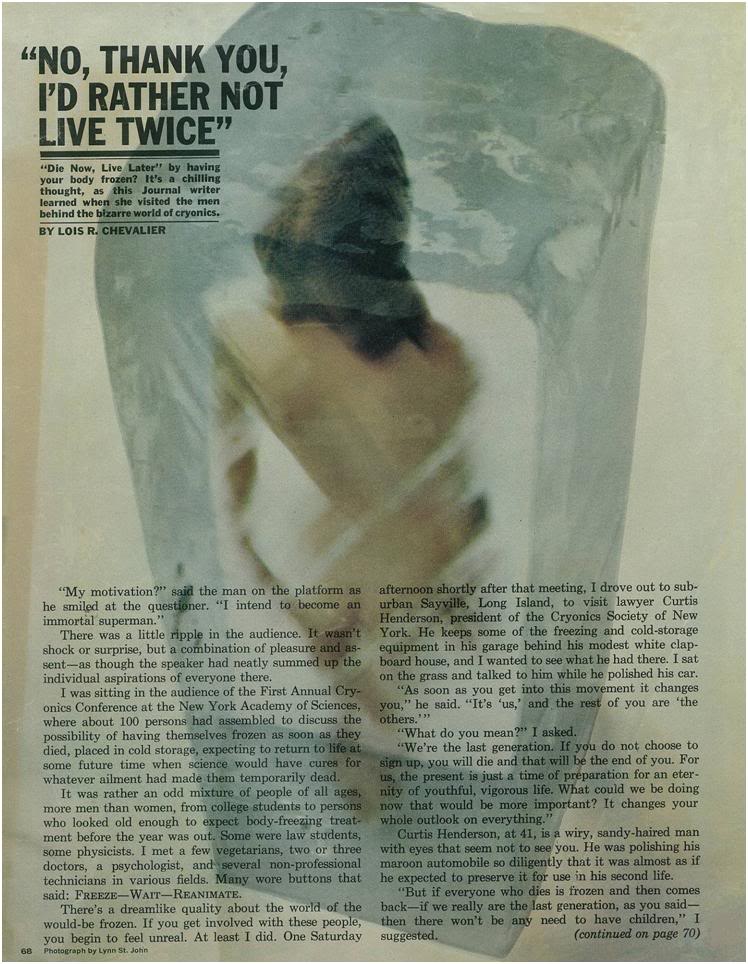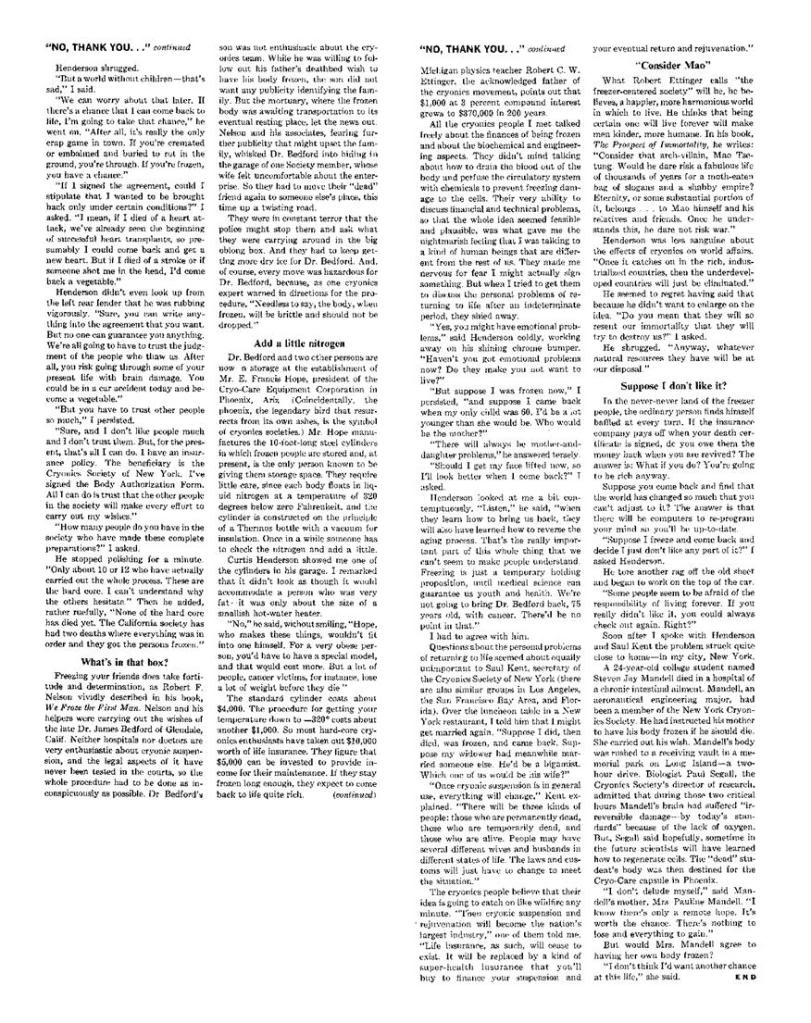By Charles Platt and Mike Darwin
 Beverly Greenberg nee ’Gillian Cummings, with her father, in July of 1972. Photo by Mike Darwin.
Beverly Greenberg nee ’Gillian Cummings, with her father, in July of 1972. Photo by Mike Darwin.
“One day the phone rang, and there was this woman on the other end of line and she said, ‘I want you to freezer my father.’ Calls like this would happen, maybe every couple of weeks. Invariably they amounted to nothing. But Beverly Greenberg was different. She was going to freeze her father and that was all there was to it. He had been embalmed and dead for a couple of weeks. We had to dig up Herman Greenberg. Fred Horn and I went to the cemetery where he was buried in Philadelphia and supervised his disinterment. We took him back to Long Island in Fred’s station wagon and put him on dry ice. His wife Doris didn’t mind helping us; she was having a good time, getting her picture taken by Beverly.
Beverly Greenberg called herself ‘Gillian Cumming’s,’ and she made a movie of her father being encapsulated, took thousands of pictures. I had to keep running rubbing alcohol over his face to stop it from turning white with frost.
“We wrapped him in aluminum foil just like we did all the bodies in those days. Foil looked good. Better than naked. And fully clothed didn’t look right either. It also kept the body from getting that frosty-coke-bottle effect.”
“It didn’t seem real, freezing people, at first. We were mostly travelling around with Harry and Paul and all the hippies, it was a party atmosphere.”
“A pre-cooled stretcher, bearing the body, was moved into the pre-cooled tank (dry ice), using an engine lift. I was always terrified of puncturing the tank, because a microscopic hole will ruin the vacuum. The metal walls of the inner can were thinner than a dime.”
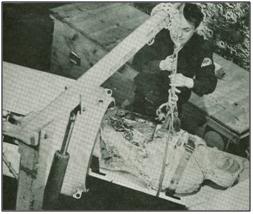 Curtis Henderson placing Herman Greenberg into liquid nitrogen storage in 1971. Photo by Gillian Cummings.
Curtis Henderson placing Herman Greenberg into liquid nitrogen storage in 1971. Photo by Gillian Cummings.
“CSNY and Cryo-Span were barely limping along when Beverly showed up. She had a bulldog commitment to cryonics and incredible energy, and she was smart, really smart. I think she was probably our last chance to make a go of cryonics in New York with CSNY and Cryo-Span. But Beverly died, and her mother never wanted any part of this, so her father was buried somewhere here on Long Island.
“Beverly used to sleep in the facility, because my wife wouldn’t let her come here. And the police said she died of carbon monoxide. I think it could have been Valium – and alcohol – along with the cold. She used to run the engine for a short while in her car, where she slept, in order to warm up during the night. Maybe she fell asleep or maybe she didn’t run the engine and got hypothermic.”
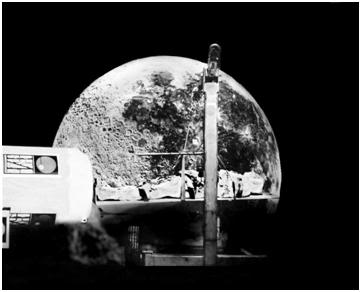 CSNY patient Herman Greenberg immersed in liquid nitrogen; the liquid level is midway on his forehead. This photograph was made in 1971 by his daughter Gillian Cummings (nee’ Beverly Greenberg).
CSNY patient Herman Greenberg immersed in liquid nitrogen; the liquid level is midway on his forehead. This photograph was made in 1971 by his daughter Gillian Cummings (nee’ Beverly Greenberg).
The police went in there and found that there were bodies. The health department came and wanted to fine me $1,000 a day. After Greenberg was buried, I only had one body at that point, the father of a guy named Michael Baburka. I told him I had to shut down and so he took the tank and put it into a mini-storage place.”
“It became more and more obvious that to do this, we had to be better funded, none of this back-alley stuff. We were going to end up getting sued; it was going to blow up in our faces. So, the retreat was necessary. Nelson didn’t see this; he sailed the whole thing into the ground. Beverly went out there to Chatsworth and got into that facility, and saw that everybody had thawed out; that was one reason for the big fight with Ettinger. Mike Darwin had gone out there a year or two earlier, and he figured out the same thing, and started telling Ettinger that the bodies were thawed at CSC and that Nelson was a fraud, but Ettinger wouldn’t listen. He backed Nelson. Alcor has the files to prove it. Ettinger was still referring people to Nelson, and we felt he should have known. Why didn’t he go and see? How could he deal with Nelson if Nelson wouldn’t let them see his facility? Our facility was open 24 hours a day. There were pictures and films. But Nelson showed nothing.”
The Future? World Domination!
“If you revived someone tomorrow, in the prime of health and youth, I still don’t think it would move this thing faster than its going. People don’t change. People react to what happens to THEM. Certain people are born to accept the idea of cryonics, and certain people aren’t. I have never really seen anybody who didn’t grab this idea right away, but got sold on it at a later date as a result of a sales pitch.”
“In the future, you’re going to have big problems when it becomes perceived that this thing is making money. You’re going to have a lot of fraudulent people saying they can do it cheaper. There is another aspect that I never understood why it didn’t catch on, and that is the glass coffin idea. People spend $20 grand on a coffin, and the whole ad pitch is preservation, which it doesn’t do. Technically you could build a glass coffin and fill it with liquid nitrogen. But I’ve never been able to sell anybody on it. Just the idea of perfect preservation; you’d keep it covered to restrict radiant heat. It would be expensive, but there are people who spend that amount of money all the time. I would have thought that that would have caught on, even if coming back didn’t.”
 Brenda Peters (left) asks: What does Henderson want to do when he is revived? [1]
Brenda Peters (left) asks: What does Henderson want to do when he is revived? [1]
“World domination, of course! If I were to wake up and come back into whatever the world is, I’d probably have to deal with – even these last two or three years, I’ve started taking an EMT course – Donaldson’s papers – every day it seems like there’s a whole new technology you should be learning. You probably are going to have to spend an awful lot of time learning. Most of the people involved in this are constantly reading, digging into things.”
“Right now, I’d like to get this house functioning so we could rent out rooms and it wouldn’t cost me any money. I’d like to talk my friend Janet Pinkney into buying a motor home, or a boat, even better. And this summer, wooden boats are going to be given away. Nobody wants wooden boats, they’re all into fiberglass. I was happiest in my big old boat. You could live comfortable, move all over the place. On the road, I wouldn’t go anywhere in particular, I’d just KEEP GOING.”
“For 90 percent of your life you’re thinking to yourself, ‘I could only put up with this once.’ So why are you living? And of course there really isn’t an answer. You’re living because you’re living, that’s all. So, you either decide that life is worth living, or it isn’t. If it isn’t, life is something to be gotten over with. You hear that kind of thought expressed all the time.”
“One day you’ll be driving along and you hear about an airplane crash. And you think, ‘Those people were going to die sooner or later anyway.’ You’re different from them. You’re almost a different form of life. From an emotional point of view, you think of yourself as different. Ettinger once said, when I was a lot younger, ‘At my age, I’m sitting here, and what am I doing here? Why aren’t I in the South Seas?’ If you’re leading a normal life, somewhere there’s a voice telling you that if you’re lucky, you’ve got another 7 or 8 years here. So the older you get, without cryonics, well, I don’t see how it cannot affect their attitude.”
“I had a roomer up here, this man really made me think about death, because he was younger than me; he’d been a Marine officer in Korea. He would come home each night and drink a six-pack of beer; he had a car he kept immaculate. But Ruthie, one of my other roomers, said he had colon cancer. Ruthie had been an OR technician in the army, she said he was getting sicker and sicker. I got to know him, he was terribly depressed, going to the VA hospital, and one night, he was really bombed, and we both knew that the next time I took him to the VA was the going to be the last ride. When I got him there, I found they had people all lined up holding their files, it was like a Charles Addams cartoon where they have everyone waiting in line to get into hell. You just knew this was the end of it. And the only answer is to get drunk and stay drunk. You get the feeling of real loneliness and abandonment; that this is it.”
“If cryonics does nothing else, it certainly allows people to die with a feeling of hope. It does more than that for me; it takes away the feeling of the inevitability of death. Then any event in the future can be part of your life.”
“Now when you get into it, taking the EMT training, you begin to see what a fragile creature you are. Every technician sees these problems, feels he’ll never surmount them. That’s one of the big problems when you talk to cryobiologists as well: the immediate problem seems so insurmountable, the idea of going the whole way and doing this seems impossible. But that’s always been true of every field.”
“The Egyptians could have made hot air balloons; the Romans could have sailed across the Atlantic and colonized the Americas. But they didn’t. And no one knows why they didn’t. So, it could be the same for us, with cryonics. We can do it right now, but most of us don’t.”
“When you find yourself in the generation that’s now dying, you realize that now you’re in the front wave, you’re next. I don’t think it affects you right away, it comes on you gradually, down the line, seeing your own children grow up – so, yes, after my father died, this happened to me. But I don’t think it had anything to do with me getting into cryonics.”
In the Modern Diner:
“We were freezing people after they had been dead or embalmed.”
“It was show business. I never wanted to freeze people if I had to dig them up and they’d been embalmed. But Ettinger said, ‘Freeze ‘em, they’re better off frozen than not frozen.’”
Mike Darwin at the Cryo-Span facility in West Babylon, Long Island in August of 1972. Photo by Curtis Henderson.
“Mike Darwin, when he first came in 1971, started carrying on, insisting on a medical-type freezing. I knew nothing about a medical-type freezing. So it was out of the question. We were making it up as we went along. He would take samples of people’s flesh, and he’d carry on about how it hadn’t been perfused properly, it was no big news. He was 15 or 16 the first time he came here; he was very eager. He lived in Indianapolis, so we used to stop there when we were on a trip. Later on my wife, Diane, took a great dislike to him. Diane, I don’t think, had ever had personal contact with gay people, and one time Mike was talking to his boyfriend on the phone, and it blew her brains.”
Dostal
“In December of ’72, Mike Darwin and Greg Fahy were out here. Mike had taken off from high school on his holiday break and Fahy was a grad student with Armand Karow down in Georgia.[2] They came out here to see how things were going with cryonics on the East Coast. While they were here, sleeping in the facility, one our members died, a woman named Clara Dostal. Saul went over there and pounded on the door (he didn’t have a key to the place) and woke them up and told them they had to freeze her. So, there it was, Mike Darwin’s big opportunity to do medical-type cryonics. They went over to the St. James funeral parlor and Mike starts running around asking for this and asking for that. He and Greg have all these papers spread out and they’re fooling with Fred’s embalming machine. And then, in the dead of night, poor Mrs. Dostal rolls in the door and these two kids, Mike was maybe 17 at the time, and Greg was maybe 20, start perfusing her.”
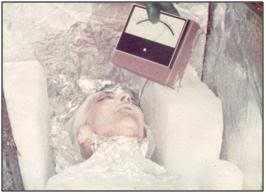 Clara Dostal on dry ice storage at the Cryo-Span facility in West Babylon, Long Island in December of 1972. Photo by Curtis Henderson.
Clara Dostal on dry ice storage at the Cryo-Span facility in West Babylon, Long Island in December of 1972. Photo by Curtis Henderson.
“We finished up early in the morning of the next day, and after we put Dostal on dry ice, I said I needed a drink. So, we headed out to this bar that was close to the facility. It was right there in amongst the cemeteries and not very far from the garbage dump. I look at Mike Darwin and he is green, absolutely green, and he is just saying over and over, ‘I can’t believe things could be this bad, I can’t believe things could be this bad. This thing is never gonna work. This thing is never gonna work.’ Reality had finally sunk in, and I guess it was at that moment that Mike decided he was going to remake cryonics in the image of medicine, or die trying.”
“It wasn’t long before Richard Dostal and Caire Halpert, Dostal’s son and daughter, were unhappy too. Soon enough, they started speaking to Nelson, and he told them he’d take care of things. But they’d already ordered their tank from MVE. He told them he’d do it cheaper. Dostal had been in dry ice at Farmingdale for two or three years and it was expensive.[3] It was five dollars a block. So they said they were going to give the body to Nelson, and so far as I knew, they were going to put her in the tank with DeBlasio in Butler, New Jersey. I didn’t know there was already another body from California with DeBlasio. Anyway, so, Dostal said the tank was going to be needed in New Jersey, which it was. But Nelson never came there, and the tank lay in the field at the cemetery in a wooden crate wrapped in a sheet of plastic for about a year.
“In any case, a guy from Maryland – I forget his name – two of his people’s heads are at Alcor, now, the ones Trans Time wouldn’t keep – he turned up on my doorstep in shorts and sandals on a bitter cold night in February of ‘73.[4] Mike Darwin had sicced him on me after he and Greg Fahy had frozen the guy’s father in Maryland. He comes in, he’s walked all the way from MacArthur airport; he couldn’t get a taxicab. He had frozen his father and needed a place to store him. But by now, I had had it up to here with cryonics. I think I’d gotten rid of everyone but Baburka.[5] In fact, I think I’d even gotten rid of him. He was put in a mini-storage facility around here. There was that much room (motions with his hands indicating a space of a few inches) between the top of the tank and roof. There was so little clearance that you could not take the lid off to fill it with liquid nitrogen. I said, ‘you’re never going to be able to fill it up with liquid nitrogen,’ but – never mind, that’s another whole novel. Baburka drove around in a 1940 Cadillac hearse that hadn’t been registered or insured since 1948.”
Trans Time
-

Art Quaife
“Anyway, I was totally out, finally clear of those bodies. I had a real good deal working for Bell and Howell. I said I’m never going to store bodies again, but this guy kept insisting, and he has a roll of $100 bills. Meanwhile I’m so broke; I’m burning the old wooden boat in the fireplace to keep the house warm. So, I go to the phone and I call Art Quaife, who says he has a freezing facility in the Bay Area, Trans Time. In the meantime, this Dostal woman still owes me $1500 for dry ice, and her tank is lying in a field in the cemetery. She wanted to be an actress. That’s why she went along with the freezing of her mother, because she thought she was going to get on television. So, I called Art Quaife, I said I got a man here who needs a place to store his father, who’s he’s just frozen in Maryland, and he doesn’t care what it costs. So there was a long silence, and then Art says, he don’t have nothing. All he has is a house that hangs off the cliff and tilts, and you walk in the door and you feel like you’re falling straight to Alcatraz.”
“In the meantime, Paul (Segall) and Harry (Waitz) had been asked to leave Stony Brook because all kinds of exotic chemicals, namely drugs, had been found in the trunk of Harry’s car. So him and Paul got into their Volkswagen minivan and went out west and set up something they called Fort Addison, in Berkeley; which again, was a house full of girls. They all managed to get on welfare. Paul kept inviting me out there, he said he could arrange for Diane and me to get on welfare and live there. But Diane took one look at Fort Addison and all the girls, and decided that that was not going to be. That was a little later, when we finally got out there.”
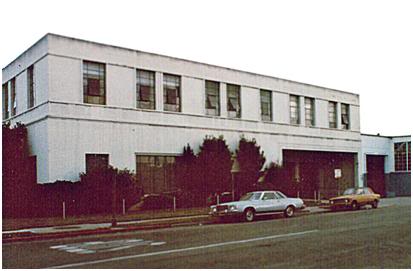 At left, the building that housed the first Trans Time, Inc., facility in Emeryville, CA. Photo by Mike Darwin
At left, the building that housed the first Trans Time, Inc., facility in Emeryville, CA. Photo by Mike Darwin
“So I said to Art, ‘this guy’s got plenty of money, why don’t you rent a facility, you need a truck with a hydraulic lift’ – I gave him a whole list of things to get. And I said; now I’m going after that tank. I got a friend of mine (John Bull) and we rented a truck with a hydraulic lift. And the guy from New Jersey is going along with this. There’s a feeling of unreality because every place he went with these credit cards and $100 bills, and we’d been starving, and now we’re renting trucks, and a private plane – he was like Howard Hughes. So we went to Jersey, and he was going to give Dostal $5,000 in cash for that tank. He’s counting out the money, and of course, I was there for the $1,500 she still owed me for the dry ice.”
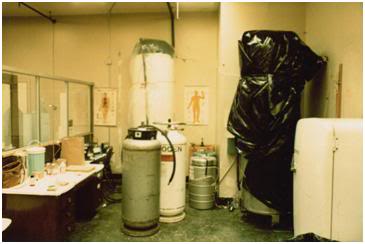 Interior of the Trans Time, Inc., facility in Berkeley California in 1981. The dewar wrapped in black plastic at the right of the photo above contained the patient from Cumberland, Maryland. Photo by Mike Darwin
Interior of the Trans Time, Inc., facility in Berkeley California in 1981. The dewar wrapped in black plastic at the right of the photo above contained the patient from Cumberland, Maryland. Photo by Mike Darwin
“Then he said he wanted me to come with him to California. I was working in a record factory and Diane’s saying to me, ‘You lose this job over cryonics and I’m leaving you.’[6] Women were constantly telling me things like this – like, ‘if we get out of this alive you’re never going to see me again.’ So I told the guy, my wife and my youngest kid have to come to California with us. And he says, ‘don’t worry about a thing, he’d pay for everything.’[7] He got the body, he got the tank, bribed somebody at Kennedy to get it on a plane or something, I don’t know.”
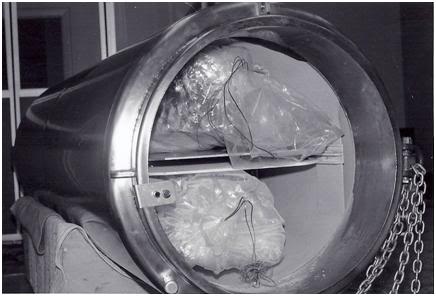 The first two Trans Time patients immediately prior to the dewar being hoisted into an upright position for cool down to liquid nitrogen temperature. Photo by Jim Yount.
The first two Trans Time patients immediately prior to the dewar being hoisted into an upright position for cool down to liquid nitrogen temperature. Photo by Jim Yount.
“We got to Berkeley, to Paul Segall and his commune, and this guy gave him the credit cards to go out and buy food and so on. You have no idea how unreal all this was. We got all the stuff together, made a cart with wheels to move the tank—and that’s how Trans Time got created.[8] And sometimes, when I see Art Quaife writing about how single-handedly, from one room, he started Trans Time, I feel—well…”
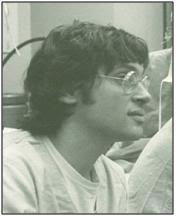
Paul Segall
“Paul and Harry provided all the labor, and this guy was feeding them from McDonald’s. They rented a place; they took the tank in there.”
The Second Great Cryonics Melt Down
Commenting on the Second Great Cryonics Meltdown in Butler, New Jersey:
“I hadn’t heard from John Bull or DeBlasio for a couple of years. One day I get a phone call, and they tell me they need me. Well, relations hadn’t been good. I was always out there taking the risks. This time, I thought, it’s going to be different.”
“They told me the tank holding DeBlasio and Dostal is leaking, and can I get out there and help them? So I went out to Mount Holiness cemetery, and there it was. Nelson’s idea had been to buy a number of cemetery plots and build a concrete vault underground. So now the bodies are buried in a cemetery and it’s supposedly all legal. This one in Jersey was really nothing but a concrete well with a wooden hatch over it. And it was half-full of ground water, rain water, whatever. They had a big back-hoe pulling the tank out of the ground, with vapor hissing out all over the place. It looked like they were launching a missile. What had gone wrong was, instead of topping up the tank with nitrogen themselves; they contracted with a delivery service from General Dynamics.”
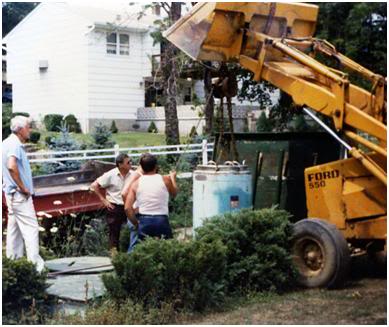 Ann DeBlasio’s dewar being hoisted out of the vault in Mt. Holiness Cemetery in Butler, New Jersey, in July of 1980. Left to right: John Bull, Nick DeBlasio and the two cemetery workers who operated the backhoe. Photo by Mike Darwin.
Ann DeBlasio’s dewar being hoisted out of the vault in Mt. Holiness Cemetery in Butler, New Jersey, in July of 1980. Left to right: John Bull, Nick DeBlasio and the two cemetery workers who operated the backhoe. Photo by Mike Darwin.
“Now, even if you keep a tank in a very dry room, water vapor forms like a rind of ice around the top of the tank. But these people knew nothing about liquid nitrogen, nothing about cryogenics. They didn’t know that you had to gently work the lid off, for fear of putting a hole in the vacuum jacket. I’m sure the delivery man got there, and the tank was covered with ice, and he gave it a good swift kick to knock the lid off, and he put a hole in the vacuum jacket. So the thing goes like Mount Vesuvius. You know, when Nelson writes that his tank leaked and he didn’t notice it, he’s full of you-know-what. Because you will notice a liquid nitrogen tank leaking, believe me. You will hear it. Each liter of liquid turns to 800 liters of gas–NOW! You’ve got a bad leak, because you start losing your insulation, and there are no mistakes to be made about it. You will know it.”[9]
“Anyhow, they hauled it up, and Bull has this big truck. He was in the vending machine business. So we got it in the back of his truck, and the thing is roaring; the vapor is boiling off. We pull out onto the highway, and he says, suppose the cops stop us. And I’ve got a grin on me, and I say, ‘It’s all yours, John.’”
“So we got this mess to John’s house up here in Medford in this truck and I still didn’t realize it wasn’t Dostal in the tank with DeBlasio’s wife. It was some woman from California who Nelson froze. Later on, her son was the one who paid Mike Darwin to come here and give her a decent funeral.[10] At that time, Mike was desperate for a tank, but that was later on.”
“First of all, Bull wants to pull into my house, but my wife came running out and she’s going to call the police immediately if we attempt to get those bodies out of the tank there. So, we went to Bull’s house. Meantime, they’d built a giant dry-ice box and they were going to put both bodies in it. Now there’s the job of getting the bodies out of the tank. This was impossible. They had thawed out, been refrozen and were frozen in place. So then they got the bright idea they were going to melt them by putting a garden hose in there. That turned the whole inside into solid ice. I mean, it was like ‘The Three Stooges.’ Anyway, I told them, there’s nothing to do but let it melt. And we had to wait about two days for it to do that in the truck outside John Bull’s house, not far from here.”
“The stretcher wouldn’t come out, nothing would come out. So I got the wrenches and crawled into this tank. DeBlasio’s wife was in pretty good shape, but the other woman, whoever she was, was nothing but a puddle at the bottom of the tank. So, we finally got ‘em out and put ‘em in the dry-ice box. Afterwards, I went upstairs to the bathtub and I had a pint of vodka, I drank the pint of vodka and I soaked for a day up there, and I could still smell it. And Diane burned my clothes. Anyway, Bull sent the tank to be repaired by some place in Jersey.[11] DeBlasio was cheap; he wouldn’t send the tank to MVE to get it properly fixed.”
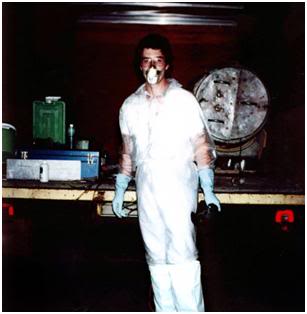 Mike Darwin preparing to remove the decomposed bodies of two former cryonics patients from the first MVE dewar in July of 1980.Photo by Joe Allen.
Mike Darwin preparing to remove the decomposed bodies of two former cryonics patients from the first MVE dewar in July of 1980.Photo by Joe Allen.
“I didn’t hear from them for a while. Another year went by. I get a call from Mike Darwin, and he tells me the thing has melted down again. They had fixed it and put it all back in there. Mike says it’s melted down and he’s made this deal to come and get the tank, and DeBlasio’s agreed to have his wife buried. That tank was the first tank at Alcor.[12] Mike came and I met him in a motel, we went out to Mount Holiness, and he had contacted a funeral parlor in Brentwood. It looked just like the Addams Family mansion. And here’s Gomez, and the woman with the long black dress. And I mean his name really was Gomez! Anyway, Mike put the tank behind the funeral parlor in a Ryder rental truck, and we said there’s nothing you can do, you got to wait till it melts, no matter how bad it stinks. And it stank, believe me. I told them there was no way I was going back in one of them tanks with them bodies in there in that condition. No way! So this time Mike went in and got the bodies out. And he got his tank. He was staying over at my house while he was doing all this. Back then, I had a beautiful vegetable garden in the back, and Mike has this guy with him, and they’re talking back and forth like a man and a girl, you know.[13] Diane – she couldn’t take it. She blew up, and Mike never came back here till after Diane was gone.”
“I was doing a lot of drinking. My second wife drank like a fish. Since then, I’ve spent a lot of time at AA. I’ve learned a lot. It doesn’t work, having two alcoholics in the house. Sooner or later one convinces the other to go out on a binge, riding around on a motorcycle, losing your false teeth, one thing and another.”
“Many times cryonics was the thing that was blamed for our problems, and it certainly didn’t lead to a tranquil home. Diane was a party-girl, if things were going good, fine, but if things were bad, if it looked like Dostal was going to serve papers on me and drag me into the suit against Nelson, Diane panicked. And in many ways, it was true; I was running between the raindrops. So, cryonics didn’t contribute to a happy home. The time we went to California, she ended up spending most of time in a motel room with the kids, because she wouldn’t go over to Fort Addison, and I didn’t blame her. But the thing is I can’t say my marriages would have survived without cryonics. The second one would have certainly broken up, because that was mutually assured destruction.”
“My parents fully believed that drinking came from capitalism, and in a communist world there wouldn’t be any drinking. The communists didn’t drink, didn’t have marital troubles, because all these things came from the evils of capitalism.”
“I had it up to here a couple of times with cryonics, but it wasn’t cryonics, it was the way we were doing it. This is why, when they started Alcor, we talked about it many times, that we would never touch anybody except somebody who was prepared ahead of time and fully understood what they were getting into. DeBlasio certainly didn’t comprehend what he was getting into, and Mandel’s mother didn’t comprehend—the only one who really did was Hearst. He worked at the University of Pennsylvania in Pittsburgh. He had a beautiful house; his wife was an architect who designed it. And he could afford it, it wasn’t a strain. If it’s going to change someone’s lifestyle to have someone frozen, sooner or later, you’re going to have problems. It got to the point where if someone called me and said they had to have someone frozen and they didn’t care what it cost- I’d hang up.”
“Hearst did a lot of the research on urine tests for drugs. He lost his grant, and he thought there was going to be a nuclear war anyway, so he packed everything up and moved to New Zealand. He said he didn’t want to keep his father anymore, so he asked us to bury him, and we buried him.”
Fini
When Beverly died, that was really the end. I didn’t realize it at the time, but it was. You know, Mike came here when he was seventeen, and he lived in my house. But what was important was that he came back when Beverly died. Mike and Gregory Fahy were the only ones who stood by me in the early seventies, they were the only ones who came to try and help when Beverly died, when everyone else ran away. Even Ettinger ran away.”
“Getting someone out of a tank is feasible if the tank has been functioning. It’s a tricky business, but it can be done. What you’ve got to do is get the liquid level down, then you lay the thing down on its side, and most of the nitrogen left is going to pour out. You’re not dealing with ice. The minute you’ve got ice, you’ve got bad news. So, I got Greenberg out, and I put him in the truck and pulled into the cemetery, and it was a Saturday and all these funerals were going on. By now, I’d had it, my life was falling apart. Diane had run back to her mother’s, all that baloney. So I was in no mood to fool with anybody. I pulled up to the office, I said I’d got Greenberg here and could they give me a hand to unload him. These guys came and looked at him, totally white, all covered in frost, and they didn’t want to touch him. I said, I’m going to roll that thing over and he’s going to fall out and bust in a million pieces right here on the pavement. So they give me these three guys, they put the coffin next to the truck. I lifted the lid off, they took one look in there, and he looked perfect but he was snow-white. Those boys stepped back and they said no way, they wouldn’t touch him. So I tipped the box up and he rolled right into the coffin, and that was the end of that.”
“I don’t know that all this makes cryonics look very good, maybe more like a freak show. Actually it was very tragic. Beverly had spent a lot of money, a lot of time getting her father frozen. Once again it emphasized the whole weakness of a relative, or any one individual being responsible for the frozen person.”
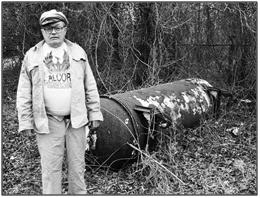 Time ravaged tank and time ravaged man: Curtis Henderson with the CC-101 in the back yard of his home at 9 Holmes Court in Sayville, LI, NY in 1992. Photo by Charles Platt.
Time ravaged tank and time ravaged man: Curtis Henderson with the CC-101 in the back yard of his home at 9 Holmes Court in Sayville, LI, NY in 1992. Photo by Charles Platt.
- Postscript: After 82 years, at 04:15 EST on the morning of Thursday, June 25th, 2009, Curtis Henderson’s heart ceased to beat. A team of technicians was standing by to start the cryopreservation procedure. A few days earlier, critically ill with end stage liver failure, he refused all further life supporting treatment and requested that he be allowed to be cryopreserved. Today, he rests in liquid nitrogen at the facilities of the Cryonics Institute in Clinton Township, Michigan.See:http://www.suspendedinc.com/cases/Stabilization%20and%20Transport%20Case%20Report%20CI95.pdf
http://www.cryonics.org/reports/CI95.html
______________________________________________________

Charles Platt
My sincere thanks to Charles Platt for conducting these interviews with Curtis Henderson, and for so generously allowing me the opportunity to present them to the world. -MD
Footnotes
[1] Brenda Peters is a long-time cryonics activist, cryopreservation team and research team member, and was the President of CryoCare, a cryonics membership organization created when Alcor underwent schism in 1993. MD
[2] Greg Fahy was a first year graduate student in the Department of Pharmacology at the Medical College of Georgia (MCG). He had selected MCG because Armand Karow was one of the few organ cryopreservationists still doing research in the US at that time.
[3] Mrs. Dostal was frozen on 10 December, 1972, and RM was frozen 09 February of 1973 (Unpublished Case Data, Alcor Life Extension Foundation, Patient A-1056, 09 February, 1973). So, only a year had elapsed from the time of Mrs. Dostal’s freezing. The facility was technically in West Babylon, but everyone referred to it as being located in Farmingdale, which was the larger community a street or two east of Eads Street. MD
[4] The “guy from Maryland “was RM, Jr., who was from Cumberland, Maryland.
[5] In April 1974 Henderson froze Michael Baburka, Sr., who was then stored privately by his son for a few months before being thawed and, still in his MVE dewar, buried in Potter’s Field on Long Island Sound. MD
[6] The “guy from Maryland” was RM, Jr., and he was from Cumberland, Maryland. He was a very nice man who deeply wanted and believed in cryonics, as did his mother, KVM. They owned the liquor store in Cumberland and were quite wealthy and influential – very respected in Cumberland. All three were “the born-not-made-type” of hard-core cryonicist. I stayed at their home, which had a spectacular view of a mountain opposite it – the whole front of the home was glass. This was at the height of the Nixon and Greenspan’s Phase I, II, III economic plan which had caused total havoc, including terrible gasoline shortages as a result of the Arab Oil Embargo and Greenspan’s price controls. They had to bribe people for fuel and it took awhile to get enough aviation gasoline (under the table) to fly RM, Sr., out – so I spent the night and day at their house and flew out with RM, Sr., to Detroit where Ettinger had a “dry ice box” – a pitiful thing made of an air shipper and fiberglass batting. GF flew back on a commercial flight so as not to miss any more classes or get kicked out of grad school for freezing dead bodies.
[7] I was very skeptical of RM, Jr., until he showed up at the Augusta, Georgia airport in a chartered plane (big enough to take all the equipment and 4 passengers) and opened a large box of Kruegerrands – gold, gold, gold. “You can take this in lieu of cash,” he said, “There wasn’t time to get to the bank”. No need to take the gold – I trusted him from then on out. Gold has this magical effect on people. I never forgot that, and I always made sure Alcor had physical custody of gold and a fair bit of it. $5,000 worth of gold was what was poured out onto Constitutional Attorney Chris Ashworth’s desk when I was being arrested in the Dora Kent case. It worked then, too. MD
[8] Actually, Trans Time began storing patients starting with RM, Sr., whom Curtis and I referred to them. The rift with Ettinger was over the horrible conditions that existed at CSM which I discovered when I froze his mother: filth, bugs, glycerol in used milk bottles from the Palmolive Soap Company that was so impure it had a yellow-green hue, a perfusion machine built by Walter Runkel in which the rubber tubing had rotted away inside; thus it kept dumping batches of perfusate into the heat exchanger bath! MD
[9] A slow vacuum failure can and has gone undetected – that’s how Trans Time warmed up HH’s father to circa -50 degrees C. However, Nelson probably never had a decent vacuum on the Cryo-Care tanks and when they failed they failed spectacularly – the outer jacked likely iced-up like a badly frosted freezer and a jet of vapor would have come out of the vent tube. The fill and vent tubes were forever freezing up due to poor design. If the vent tube occluded you got a jet of LN2 out the fill line! If they both iced up at the same time you would have had an explosion. MD
[10] It was the patient, DL’s son PL, who paid Soma, Inc., to come out and extricate the remains.
[11] The company was Cryofab, located at 540 North Michigan Ave. Kenilworth, NJ 07033.
[12] That was not Alcor’s first whole body dewar. I sold the DeBlasio dewar to Trans Time and used the proceeds to help with the expense of moving IABS, Soma, Inc., and myself to California. The first Alcor dewar was bought with money provided by Dick Jones to get out from under paying Trans Time $16,000/yr to keep RM and KVM frozen after RM, Jr., was killed in an auto accident. It was a brand new dewar from MVE, ordered under the pretense of being used for high temperature (-196 oC) superconductor research. I created a dummy company to order it and had a fake drawing of this big long equipment package made. Since I hated side-rails and fill tubes, they didn’t suspect a thing. It’s an easy dewar to pick out from the pack because it is the only one with the MVE logo on it. MD
[13] This was a misperception, and a puzzling one at that. Joe Allen was not gay and I have no recollection of our ever interacting in the way described. Joe is very slightly built – almost child-sized. Perhaps in Diane’s mind this meant we were homosexual lovers. Joe Allen lives with his wife and 4 children in Australia where he relocated to over 20 years ago.
